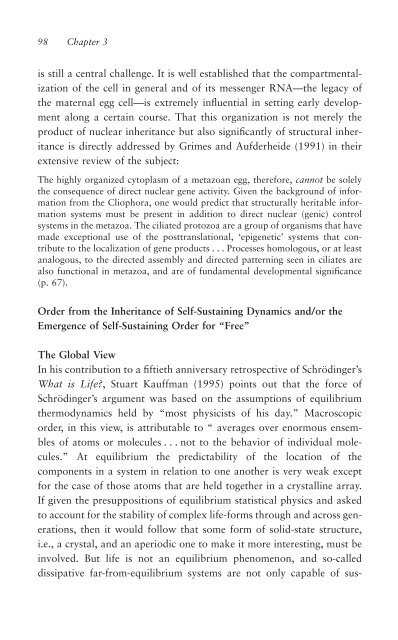A Critique of Pure (Genetic) Information
A Critique of Pure (Genetic) Information
A Critique of Pure (Genetic) Information
You also want an ePaper? Increase the reach of your titles
YUMPU automatically turns print PDFs into web optimized ePapers that Google loves.
98 Chapter 3<br />
is still a central challenge. It is well established that the compartmentalization<br />
<strong>of</strong> the cell in general and <strong>of</strong> its messenger RNA—the legacy <strong>of</strong><br />
the maternal egg cell—is extremely influential in setting early development<br />
along a certain course. That this organization is not merely the<br />
product <strong>of</strong> nuclear inheritance but also significantly <strong>of</strong> structural inheritance<br />
is directly addressed by Grimes and Aufderheide (1991) in their<br />
extensive review <strong>of</strong> the subject:<br />
The highly organized cytoplasm <strong>of</strong> a metazoan egg, therefore, cannot be solely<br />
the consequence <strong>of</strong> direct nuclear gene activity. Given the background <strong>of</strong> information<br />
from the Cliophora, one would predict that structurally heritable information<br />
systems must be present in addition to direct nuclear (genic) control<br />
systems in the metazoa. The ciliated protozoa are a group <strong>of</strong> organisms that have<br />
made exceptional use <strong>of</strong> the posttranslational, ‘epigenetic’ systems that contribute<br />
to the localization <strong>of</strong> gene products ...Processes homologous, or at least<br />
analogous, to the directed assembly and directed patterning seen in ciliates are<br />
also functional in metazoa, and are <strong>of</strong> fundamental developmental significance<br />
(p. 67).<br />
Order from the Inheritance <strong>of</strong> Self-Sustaining Dynamics and/or the<br />
Emergence <strong>of</strong> Self-Sustaining Order for “Free”<br />
The Global View<br />
In his contribution to a fiftieth anniversary retrospective <strong>of</strong> Schrödinger’s<br />
What is Life?, Stuart Kauffman (1995) points out that the force <strong>of</strong><br />
Schrödinger’s argument was based on the assumptions <strong>of</strong> equilibrium<br />
thermodynamics held by “most physicists <strong>of</strong> his day.” Macroscopic<br />
order, in this view, is attributable to “ averages over enormous ensembles<br />
<strong>of</strong> atoms or molecules . . . not to the behavior <strong>of</strong> individual molecules.”<br />
At equilibrium the predictability <strong>of</strong> the location <strong>of</strong> the<br />
components in a system in relation to one another is very weak except<br />
for the case <strong>of</strong> those atoms that are held together in a crystalline array.<br />
If given the presuppositions <strong>of</strong> equilibrium statistical physics and asked<br />
to account for the stability <strong>of</strong> complex life-forms through and across generations,<br />
then it would follow that some form <strong>of</strong> solid-state structure,<br />
i.e., a crystal, and an aperiodic one to make it more interesting, must be<br />
involved. But life is not an equilibrium phenomenon, and so-called<br />
dissipative far-from-equilibrium systems are not only capable <strong>of</strong> sus-
















